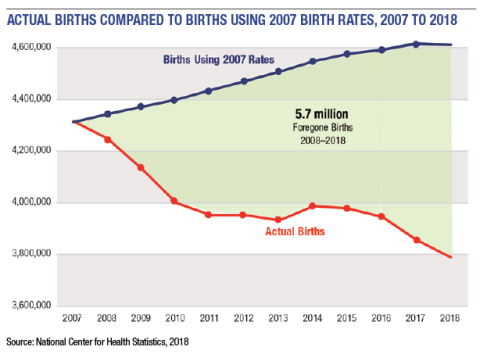download the brief
Key Findings

For 11 years births have declined, though the number of child-bearing age women has grown.
National Center for Health Statistics data for 2018 show the lowest general fertility rate on record and just 3,788,000 births—the fewest in 32 years. There were 528,000 fewer births (12 percent) in 2018 than in 2007, just before the Great Recession began to influence births. This decline in births is entirely due to reduced fertility rates among women in their 20s and teenagers. Fertility rates remained stable or grew slightly among older women. The number of women of prime child-bearing age (20–39) actually increased by 3.2 million (8 percent) between 2007 and 2018. Had pre-recessionary fertility rates been sustained through 2018, there would have been 800,000 more births last year and 5.7 million more births over the last decade. A critical question now is: how many of these 5.7 million births are being delayed, and how many will be foregone entirely? This has immediate implications for health care, schools, child-related businesses, and eventually for the labor force.

Kenneth M. Johnson is senior demographer at the Carsey School of Public Policy, professor of sociology at the University of New Hampshire, and an Andrew Carnegie Fellow. His research was supported by the Carnegie Corporation. The opinions are his and not those of the sponsoring organization.
